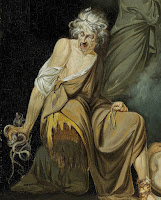For the Romans, the supernatural was as real as any other part of the world around them. Spirits were everywhere, affecting everything, and could be roughly divided into three categories. Gods and demi-gods comprised one group, including the nymphs inhabiting natural places and the spirits embodying Roman virtues. The souls of the dead comprised another: lares acted as benevolent and helpful guardian spirits, while lemures harassed the living in retaliation for unsettled scores. If a lare's family failed to honor them properly, they might make the switch to lemur, so it behooved Romans to keep the dearly departed happy; there was even a special holiday, the Lemuria, for placating angry souls and coaxing them back onto your side. The third group included supernatural beings who were neither ghost nor god: monsters, creatures, and demons, including Halloween staples like witches, werewolves, and vampires.
 |
| Erictho by John Mortimer |
As for werewolves, Virgil, Pliny, and Ovid all mention them, but they're not quite the same as the modern-day version. Their werewolves were humans who'd been turned into wolves as a punishment for some heinous crime, usually cannibalism. The werewolf legend in Rome was less of a monster story than a symbol of barbarism, of savages who were neither human nor beast but something in between. The Greek historian Herodotus wrote of a Slavic tribe who transformed into wolves once every year and danced beneath the moon, but that's as close to the modern werewolf as the legend got. The word "lycanthrope", however, does come from the Greco-Roman myth of Lycaon, a king who was transformed into a wolf for killing his own son.
 |
| The Lamia by John Waterhouse |
The Roman vampire was the lamia. The name comes from the Greek myth of Lamia, Queen of Libya, who was turned by Hera into a child-eating demon; the Romans, as per usual, took the story and created their own version, a supernatural seductress who killed not children but young, virile men. Lamiae would hang out in isolated places like marshes or lonely roads, where they would seduce travelers and then drink their blood or consume their life force. They might also appear in dreams, a forerunner of the medieval succubus. As in many vampire legends, lamiae symbolized unbridled female sexuality; in Pre-Raphaelite and Romantic art they were used to represent courtesans, mistresses, or other wanton women, often combined with snake imagery (see John Keats' poem "Lamia", where she is half woman, half snake), a cruel temptress sucking the life out of some poor innocent man.
But while there were enough legends of ghosts, ghouls, and goblins to scare the subligar off any ancient Roman, only the lemures had their own holiday. For the Romans, of all the things that go bump in the night, the scariest were not vampires, zombies, or werewolves, but disgruntled grandparents. If you kept your ancestors happy, they would make sure none of these other creepy-crawlies could get to you.
Heather Domin has been an Unusual Historicals contributor since 2011. She is the author of The Soldier of Raetia, set in Augustan Rome, and Allegiance, set in 1920s Dublin. Her newest title, The Heirs of Fortune (sequel to Soldier of Raetia) will be released on November 30.
But while there were enough legends of ghosts, ghouls, and goblins to scare the subligar off any ancient Roman, only the lemures had their own holiday. For the Romans, of all the things that go bump in the night, the scariest were not vampires, zombies, or werewolves, but disgruntled grandparents. If you kept your ancestors happy, they would make sure none of these other creepy-crawlies could get to you.
Heather Domin has been an Unusual Historicals contributor since 2011. She is the author of The Soldier of Raetia, set in Augustan Rome, and Allegiance, set in 1920s Dublin. Her newest title, The Heirs of Fortune (sequel to Soldier of Raetia) will be released on November 30.
